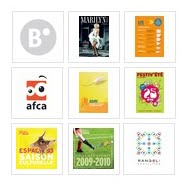I know in my own mind what I want my new brochure to look like, but I have trouble explaining this to the designer. What should I do?
For a start, do not attempt to tell designers how to design. Instead, talk to them about the business need for the brochure, the key business objectives behind it, and the desired outcomes and describe the target audiences in considerable detail. Permit the designer to ask as many questions as they need in order to fully understand your goals. Then incorporate all of this into a written design brief. The designers are the ones accountable for creative visual design solutions to your problem. It is not necessary for you to describe what those design solutions should look like. That is their job.
We often work on very tight schedules to get design work completed. Do we have to devote a lot of time to writing a design brief?
A comprehensive design brief doesn’t need to take an inordinate amount of time to develop. Once in hand, it will actually shorten the time needed to complete the design project, since every critical aspect of the project is clear to all stakeholders, and a phase process for completion of the project has been agreed upon. All of this works to ensure that you end up with a design solution that is very effective at solving the business problem.
Do I have to do a proper design brief for every design project?
Comprehensive design briefs should be mandatory for all major, or critical, design projects. However, routine design projects such as updating a price list, slightly revising a package to include new mandatory ingredient listings, or developing name badges for a sales meeting would not need a full design brief. Essentially, the latter are usually referred to as 'production' work. However, even the smallest projects should have a written statement of the business objectives, desired outcomes, and target audience for the design project.
Once we have created a written design brief, doesn't that lock us into a specific direction and thereby stifle creativity?
Since a design brief does not specify any specific design elements at the outset, it gives the designers creative freedom. The design brief deals with the desired outcomes, the reasons for doing the project, the business objectives, and the audiences you are designing for. It should not say things like, 'The colour scheme must utilise only earth tones.' The design brief is a background tool to get to core, highly creative, design concepts quickly. In special circumstances, a design brief can be revised with the agreement of each of the partners who created the original brief.
How much do designers really need to know about our target audience? Isn't that information really most important to sales and marketing?
If a designer, or design team, doesn't thoroughly understand whom they are designing for, there is no way they can meet the stated business objectives and desired outcomes for the design. Cursory target audience descriptions such as 'women aged 18 to 30' or 'customers who are homeowners' are of no use to designers. It is critical for designers to understand the target audience for their work in great detail. A proposed design solution should also be tested in some way with representatives of the target audience prior to implementation of the design solution.
(Peter L. Phillips for the Design Council)






